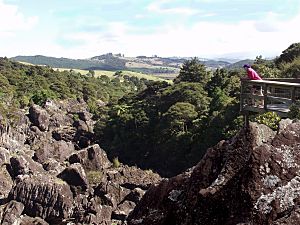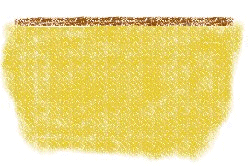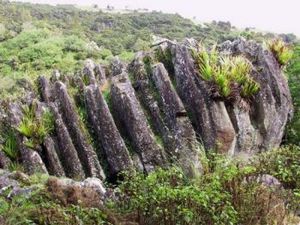Horeke basalts facts for kids
The Horeke basalts are very old volcanic rocks found in the central Northland Region of New Zealand. These rocks were once huge flows of lava that spread across the land. They formed a high, flat area, like a plateau, especially around a place called Okaihau.
You can see amazing examples of these rocks at Wairere Boulders. This nature park has paths that wind through giant basalt boulders. These boulders broke off from the ancient lava flows and are now part of a different group of rocks called the Kerikeri Volcanic Group.
How the Horeke Basalts Formed
The giant boulders you see in the Wairere valley came from lava that erupted from a volcano. This volcano was located near Lake Omapere, which is close to Kaikohe. Scientists have found that this lava flow is about 2.8 million years old!
Scientists have studied different samples of these Horeke basalts. They found two main ages: one at 2.84 million years and another at 2.67 million years. There are also small differences in the chemicals that make up these rocks. This suggests that the volcano erupted several times, sending out many lava flows. These flows once covered a large, high area to the east of Horeke.
How the Wairere Boulders Were Created
Imagine the basalt lava flows as a hard cap on top of softer clay ground. Over millions of years, water and weather slowly wore away the clay underneath this hard basalt cap. This process started to create a V-shaped valley.
As the clay eroded, the edges of the heavy basalt cap became unsupported. Large pieces of the basalt cap broke off. These huge blocks then slowly slid down the hillsides towards the bottom of the valley. Over time, these giant boulders piled up. Today, they fill a part of the valley that is about 1.4 kilometers (almost a mile) long and up to 350 meters (about 1,150 feet) wide.
Unique Channels on the Boulders
If you look closely at some of the boulders, you might see unusual channels or grooves carved into their surface. Some of these channels are as deep as 1 meter (about 3 feet) and up to 30 centimeters (about a foot) wide. This is quite rare for basalt rocks!
These channels formed because of a special process called chemical leaching. Over time, decaying plants and leaves on top of the boulders created a layer of humus. Rainwater passing through this humus became slightly acidic. This acidic water then slowly dissolved and washed away parts of the basalt, creating these unique channels.




